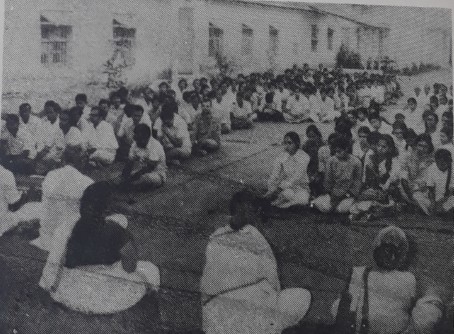A medical college, known by any other name, would still produce MBBS and MDs. Wasn’t it William Shakespeare who wrote in Romeo and Juliet: ‘What’s in a name? That which we call a rose by any other name would smell as sweet.’
Well, it does matter. 𝗠𝗚𝗜𝗠𝗦 certainly sounds better than 𝗠𝗚𝗖𝗠𝗦.
Back in 1969, MGIMS, as it stands today, did not exist. If this is true, why do we say that this institute was born in 1969?
Well, when the first batch of medical students arrived in Sevagram in 1969, it bore the name Mahatma Gandhi 𝗖𝗼𝗹𝗹𝗲𝗴𝗲 of Medical Sciences. It took two years for the college to grow into an 𝗜𝗻𝘀𝘁𝗶𝘁𝘂𝘁𝗶𝗼𝗻 and earn the acronym MGIMS.
The first principal of this budding institution was Dr. M.G. Kane, a Professor of Anatomy. His tenure was brief, lasting only a month, before he handed over the reins to Dr. I.D. Singh, a Professor of Physiology.
Dr. Singh had an ear for music. He possessed a remarkable affinity for music, which he seamlessly integrated into the fabric of medical education. He played harmonium. The instrument helped him address the early challenges of a medical colelge with grace and creativity, orchestrating harmony amid the discord.
Picture this: a group of medical students in khadi, seated cross-legged on the floor, singing ” वैष्णव जन तो तेने कहिये” In their midst, the principal of the medical college, adorned with a turban, plays the harmonium—his hands deftly moving across the keyboard and bellows.
How many medical colleges would you witness such a spectacle—the principal seated on the floor, skilfully playing the harmonium, while medical students sing a devotional song?
Yet, this was, and still is, a regular sight at MGIMS—a scene reminiscent of a classic Raj Kapoor film from the sixties.
This unique harmony of tradition and education became the hallmark of MGIMS. While I might indulge in alliteration, Simplicity, Serenity, and Sevagram became synonyms.
And this was no serendipity.

During 1969 and 1970, we all had to attend early morning prayers led by Panditji. He would take roll call and recognize each of our voices. If anyone attempted a proxy, Panditji would laugh and say, “Ha..ha..ha,” without ever getting angry.
Great nostalgia, I must say. Every article of yours takes us down memory lane to those much-cherished moments. Thank you, SP sir, for taking the time to write and share these with all of us. 🙏🙏
Sir, you could compile all these stories into a book!
Pranam to both Dr. Kane Sir and Dr. I.D. Singh, as well as to the doctors from the first batch of 1969. Pranam to Dr. S.P. Kalantri for writing such a wonderful article.
This picture brings back vivid memories from the past! It speaks volumes.
True, sir. I was also admitted and operated on in that old building in December 1975 and January 1976 by the late Dr. Chaturvedi. Due to a certain disorder, I was in the hospital for about 10-15 days, though I don’t remember the exact duration. I was referred to Bombay for further testing. Meanwhile, Dr. Chaturvedi left MGIMS and joined a hospital in Bombay. He was kind enough to visit the clinic in Bombay where I went for further testing. He personally spoke to the expert doctor and returned to the clinic for the report. I feel deeply indebted for the care he took of me. I was in the first year of my graduation at that time. I also remember the caring nursing of the Malayali Sisters. Now, we miss that level of care, dedication, devotion, and love. 🙏🙏🙏🙏
In the past, doctors prioritized patient care, acting in their best interests. Medicine then was about healing, combining art and science, not driven by profit as today. This shift may explain why modern patients, despite paying more, are less satisfied and skeptical about treatments. It reflects commerce triumphing over art and science in medicine.
Reflecting on Friday Prayers, 1992 to 1997.
Dr. S. Pandey, then HOD of Physiology, skillfully played the Casio.
Gayatri Vyas, Suchi Gaba, Sasha Kothari, and I took turns leading the chorus.
Every week, Dr. Pandey would compose a Bhajan of his own creation…